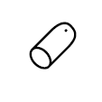A silicone finger prosthesis realistically recreates the missing finger.

A finger compression element brings the residual limb into its stable, final shape.
Make an appointment over the phone or send us a message!

Aesthetic and functional
Prosthetic solutions for the finger
The hand is one of the most complex organs in the human body. It has many functions in body language, gestures, and expression. Likewise, it is a sensitive and highly differentiated functional unit for our day-to-day actions.
Therefore, the demands of a finger prosthesis are high. Such a device must not only realistically depict the finger, but also withstand the enormous forces and wear requirements of everyday life.
Our silicone finger prostheses

A finger prosthesis serves as a functional and cosmetic replacement for the missing finger or thumb. It is made of flexible silicone that is precisely adapted to the individual stump.
Because the limb difference is always in the viewer’s field of vision, the desire for a look that is as lifelike and discreet as possible is strong.
Our silicone experts reproduce even the finest details, such as pigment spots, small hairs or distinctive skin features. With a layered integration of different shades, we are able to get extremely close to the original skin color. The overall appearance of the prosthesis is enhanced by a detailed replica of the fingernail made of acrylic resins or silicone. Not only does the result look deceptively real, it can even be painted with nail polish.

Silicone is very easy to use in the region of the upper extremities. Thanks to the flexible and resilient properties of the material, excellent solutions can be found even for the most difficult treatments.
By combining silicones of different hardnesses, an optimal fit of the finger prosthesis can be ensured. The excellent adhesive properties of the silicone material also make closures and clasps unnecessary. Fixation of the prosthesis is achieved by biomechanical shaft stabilization and a full-contact, circular compression design of the prosthetic shaft. The use of highly elastic and adhesive medical silicones ensures good adhesion even with short finger stumps. The fit of the prosthesis is tightened with the aid of a fitting gel, which temporarily removes the adhesive effect between the prosthesis socket and the residual limb.
The acceptance of the silicone material is very high because it is physiologically inert and biocompatible. This means that no allergic reactions will occur when wearing a finger prosthesis. You can confidently wear your prosthesis all day long.
Course of treatment
Several visits to Pohlig are required to produce a finger prosthesis. The number of visits in each case is based on various factors, such as the nature of the stump conditions and the coloration requirements of the skin. Experience has shown that the manufacture of a finger prosthesis requires between three and six visits.
Detailed consultation and assessment. After submitting a prescription, we prepare a cost estimate for your health insurance and submit a request for coverage of costs. The second visit takes place after approval has been granted by the health insurance company.
A mould of the hand area to be treated is made using silicone or plaster. A mould of the opposite hand is also made for reference. In addition, the dimensions are taken and the first color selection is made for skin and nails.
Testing of compression elements or fitting of the trial prosthesis, color control and final color matching. Wearing the compression elements requires a period of two to eight weeks, depending on the stump conditions.
Reserved for possible changes in the finger prosthesis.
Fitting and delivery of the final prosthesis. Instruction in the handling and use of the prosthesis, care instructions.
The subsequent fitting of a follow-up or replacement prosthesis allows a reduction in the number of preparation and visit appointments, provided that the stump conditions remain the same and the basic model is used.
Functionality
What is possible with a silicone prosthesis?
The functional design of the silicone prosthesis depends on the individual requirements of the prosthesis wearer. By combining a spectrum of construction techniques and silicone materials, a wide range of products is possible.
The focus is always on dealing with everyday situations and activities. The aim is to help the prosthesis wearer to once again be able to hold, guide and move objects such as cutlery, smartphones, pens, cooking tools or the steering wheel. The use of specially integrated and adjustable reinforcement elements allows you to carry light objects (e.g. shopping bags or handbags) or to play a musical instrument.

Here is an overview of the typical procedure for prosthesis treatment at Pohlig.
The cost of a prosthesis depends on several factors.
Example of treatment
Prosthetic thumb

Amputated thumb without prosthesis.

Thumb prosthesis.
Example of treatment
Multiple finger prostheses

Due to a milling machine accident, the patient lost three fingers.

The three silicone finger prostheses restore the external appearance of the hand and also serve as a functional replacement for the missing fingers.
A myoelectrically controlled arm prosthesis returns various natural functions to your hand. The electronic hand can perform different types of grips.
Hand and partial hand prostheses are divided into passive, myoelectrically controlled, and work prostheses.

Let yourself be inspired! We follow many interesting patients during their Pohlig appointment and give you personal insights.

For those who want to delve even deeper into the subject, we have a suitable video for almost every area of treatment!

Take a look behind the scenes at Pohlig and learn about different health conditions and our innovative assistive technology solutions!

Sometimes funny, sometimes explanatory, sometimes emotional - but above all always entertaining: our videos on TikTok!


